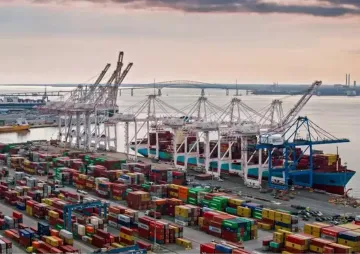 This is the 82nd article in the series
This is the 82nd article in the series The China Chronicles.
Read all the articles here.
Amidst the rising tensions of the trade war between the US and China, several debates have been brought to the forefront regarding which side is likely to win the battle or whether there is any winning at all. Perhaps the answer to these questions lies in energy security, for energy remains central to the functioning of other sectors and therefore the overall economy. It is not uncommon for a nation-state to diversify its sources of energy in the hope of shielding itself from market forces or depending excessively on a handful of countries. China too, is following this path in the backdrop of a trade war. In this context, it is intentionally or unintentionally attempting to bring the ball in its court.
With a massive energy demand, China is the largest greenhouse gas emitter which means that diversification must be achieved not only in terms of fossil fuel imports but also domestically, in moving towards cleaner and greener energy. Global concern around the environment has called for countries to be responsible powers. In addition, air pollution has been a significant issue-area for China, because of both global pressure and the state of the environment in China. Beijing has made strides in the direction of becoming a greener nation. Since the US decision to withdraw from the Paris Agreement in 2017, following the greener path, was in part to China carving out a strong position for
influencing climate negotiations.
It is not uncommon for a nation-state to diversify its sources of energy in the hope of shielding itself from market forces or depending excessively on a handful of countries. China too, is following this path in the backdrop of a trade war.
China’s renewable endeavours are best evidenced in the most
recent version of its policy paper for renewable energy. This policy aims to establish a base-level standard for renewables specific to each province. As a result of this, it is hoped renewable energy companies will realise greater profits. Simultaneously, the competitive landscape created by means of these policy incentives is likely to create obstacles for the non-renewable sector. Notwithstanding, the country continues to be the biggest consumer of coal. It has set a coal consumption target under 58% of its total energy consumption by 2020. Achieving this, could prove to be difficult as the last four years have seen an increase in coal consumption, particularly due to a
high demand for coal from power, steel and petrochemical industries.
In line with this demand, which is critical to the steel industry, the first quarter of 2019 saw China’s
increase in demand for Australian coking coal which has remained an important source of energy for China. This has been advantageous for Australia and, symbiotic relations with countries are sure to help China in its diversification goals. China imports coal primarily as a result of price differences even as it has significant domestic reserves. When the trade war seemed to be easing, despite tariffs on US thermal and coking coal, China’s coal imports from the US did rise in April in comparison to March. With all hope of a change in atmosphere quickly disappearing post Trump’s declaration of a new set of tariffs on Chinese goods in the month of May, China’s US coal imports are set to decrease again. This is likely to be more damaging for the US than China. For China,
US coal does not have an edge in terms of quality, time for delivery and price that other countries can offer, for instance, Indonesia or Australia.
With all hope of a change in atmosphere quickly disappearing post Trump’s declaration of a new set of tariffs on Chinese goods in the month of May, China’s US coal imports are set to decrease again.
The target of a decreased proportion of coal could be achieved. However, this must be viewed in the backdrop of increasing consumption. The burning of coal adds to air pollution and has led China towards efforts to increase the efficiency of coal-burning plants and encourage households to move away from coal. Progress has been made in improving these plants as well as in aiding urban households’ transition away from coal. To help rural households transition away from coal is a more challenging task as coal is responsible for 65% of the overall
emissions generated from rural households in the country. Given that China has turned to Australia and Indonesia to meet its demand for coal, it may be a preferred and viable option for it to keep away from US coal imports. If this occurs, overdependence will be avoided and to some extent, diversification attained but China’s green transition will remain a more complicated endeavour.
An ambitious renewable energy policy and a target of non-fossil fuel sources to make up 20% of its overall energy supply have aided China’s transition to greener energy. China has significantly increased even its global renewable energy spending but a complete switch from fossil fuels to renewables is unlikely in the near future. It is here that natural gas has offered a cleaner alternative. Recently, the CEO of a Chinese energy consulting firm said that
China’s liquid natural gas (LNG) needs are infinite, with the country currently meeting 43% of its demand through imports making it the second largest importer of natural gas. LNG is included in the list of American goods that China has levied tariffs on. Since the trade war began, a sharp decline has been seen in China’s LNG imports from the US.
A method to avoid overdependence on the US may be to introduce a third country in the natural gas trade equation.
With an excess supply of natural gas, the US is being pushed to look for new markets while China is
turning to other countries to meet its demand such as Australia, Qatar and specifically Russia. Some energy experts have suggested that LNG could be the means to ease if not end the trade war. Trump’s strategy places significant weight on the ability of energy exports to
reduce the US trade deficit and the ideal scenario would be that American LNG supply meet China’s growing LNG demand. However, the already tense environment makes this a difficult task. Equally, China’s programme of diversification is well underway and the proposition that the country will readily turn to the US is unrealistic. A method to avoid overdependence on the US may be to introduce a third country in the natural gas trade equation. Japan, for instance, aims to become a
global LNG hub and could purchase excess American LNG and export it to China.
China seemingly is in a greater position of control in the case of LNG trade with the US for it could help reduce the US’ trade deficit which could consequently ease tensions. However, the picture is not as clear where oil is considered. China has not levied any tariffs on American oil as of now even as it has reduced American oil imports.
US sanctions on Iran and Venezuela — both critical oil sources for China — as well as the recent decision to end waivers for Iranian oil imports has not helped the fragile environment. China remains dependent on this resource. While it is attempting to secure itself from such instabilities through continuing to import Iranian oil, heavily
investing in African oil reserves and creating a strategic petroleum reserve, US crude oil remains too important a resource for China to levy tariffs on.
China seemingly is in a greater position of control in the case of LNG trade with the US for it could help reduce the US’ trade deficit which could consequently ease tensions. However, the picture is not as clear where oil is considered.
As China has improved its refining capabilities,
energy expert Philip Verger suggests that with an economic slowdown, China’s refiners will look to increase oil product exports as domestic demand falls. This in turn could affect the refining industry worldwide and drive down crude oil prices. January 2019 did see results to this effect. Against the backdrop of an economic slowdown, China’s demand for gasoline fell which triggered an increase in China’s exports of oil products. It would be a matter of concern for the US, which has become the fastest growing oil producer should China intentionally employ this method. Similar actions taken by South Korea during the Asian debt crisis, when it exported oil products at lower prices to other Asian countries, resulted in a lowering of crude oil prices. As the trade war continues and a general economic slowdown persists, it is plausible that China could use this strategy in the near future to gain a competitive edge over the US.
In conclusion, LNG trade has potential, in some part, to ease tensions in strained Sino-US ties as China seeks to fill the gap between coal and renewables with cleaner fuel and, LNG exports for the US would assist in a reduction of its trade deficit. However, China has the upper hand in this context for it seems reluctant to give way to any dependence on the US. In addition, diversifying sources of energy and investing heavily in renewables aligns well with China’s desire to become an environmentally responsible nation. Although the US is also looking at alternative markets, China’s progress, while incomplete to fulfil its desire, until now, is apparent in its global reach in energy rich regions, from Africa to the Arctic. Besides, areas where China could apply pressure discussed above, could lead to the US losing at least marginally in the trade battle. It would be interesting to see whether China resorts to tariffs on US crude oil imports should friction between the two nations increase.
The author was a research intern at ORF New Delhi.
The views expressed above belong to the author(s). ORF research and analyses now available on Telegram! Click here to access our curated content — blogs, longforms and interviews.



 This is the 82nd article in the series The China Chronicles.
Read all the articles
This is the 82nd article in the series The China Chronicles.
Read all the articles  PREV
PREV

